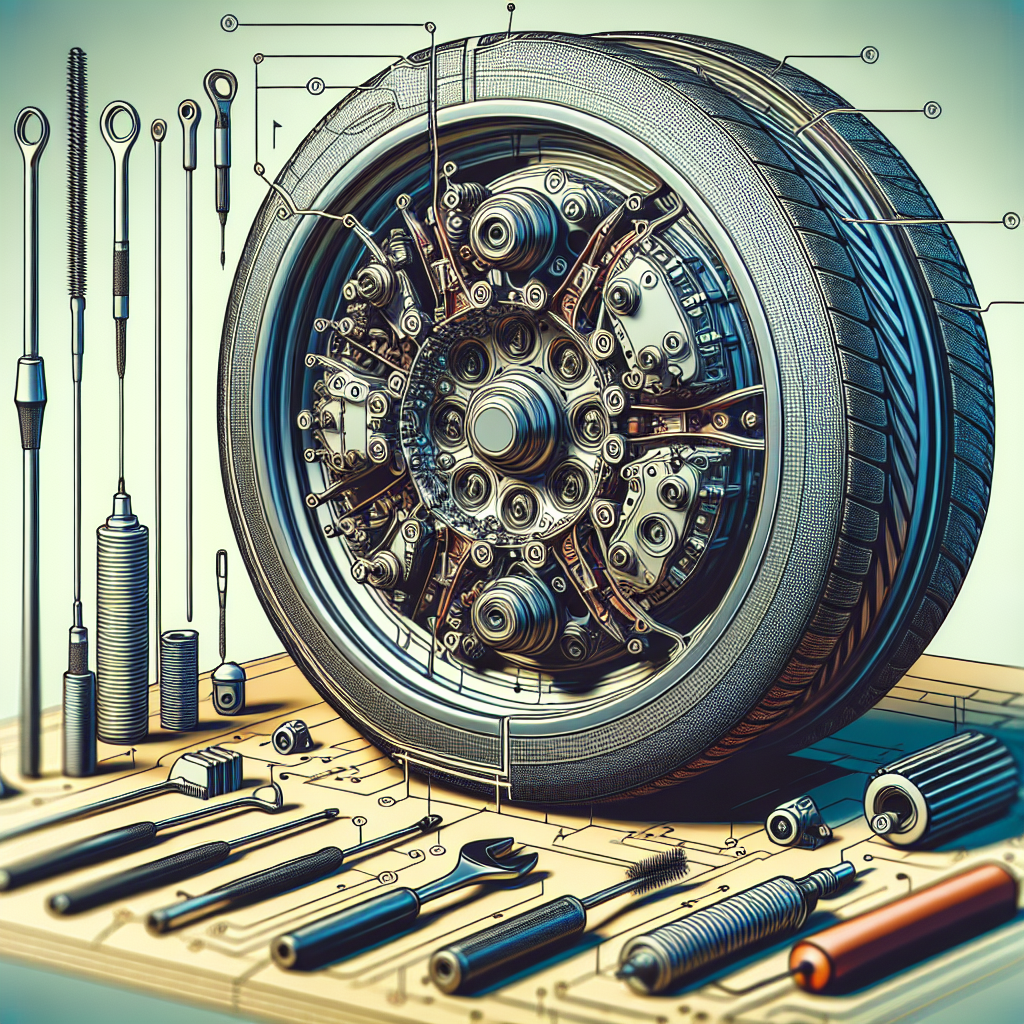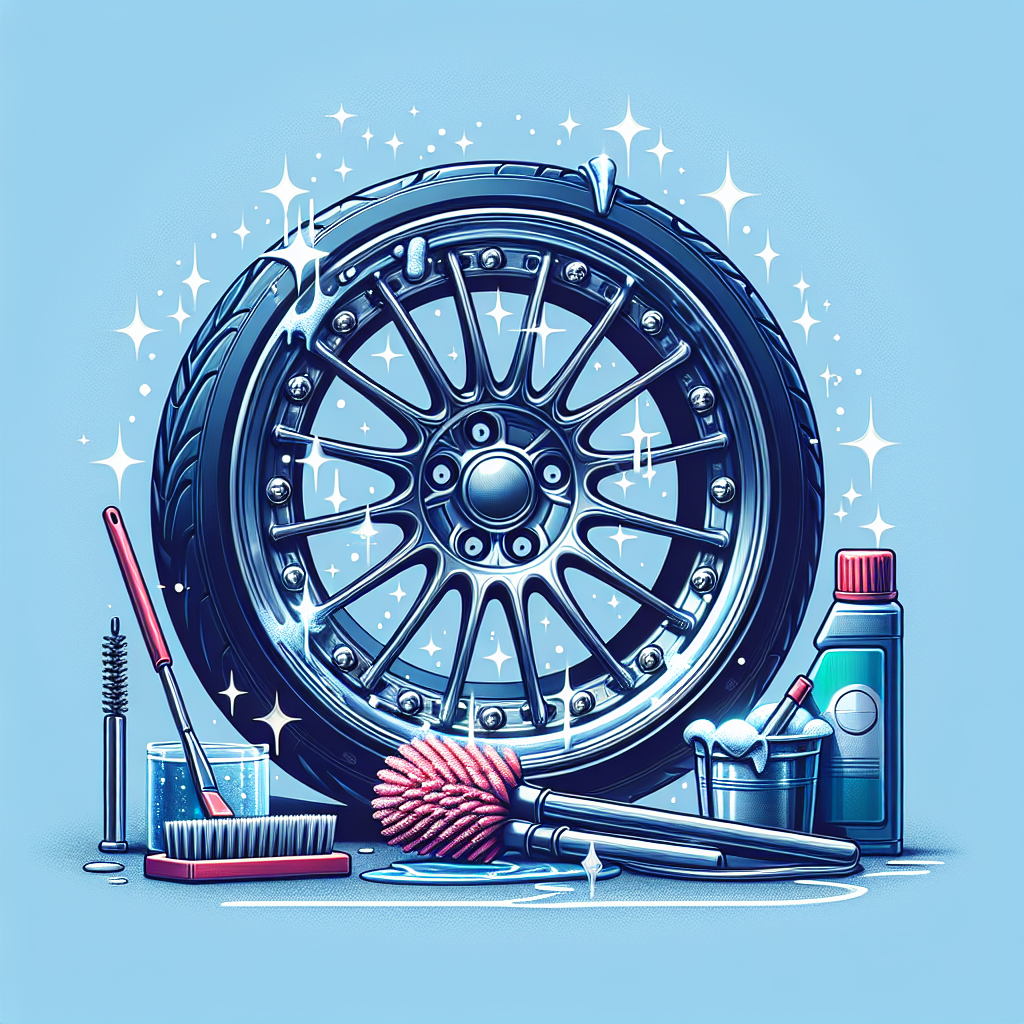Cleaning multi-piece wheels requires careful attention and precautions to ensure their longevity and appearance. With their complex design and multiple parts, it is important to take the necessary steps to protect these wheels from damage. From using the right cleaning products to avoiding abrasive materials, this article will guide you through the precautions you should take to maintain the beauty and functionality of your multi-piece wheels.

Preparation
Gather necessary tools and materials
Before you begin cleaning your multi-piece wheels, it’s important to gather all the necessary tools and materials that you’ll need for the task at hand. Some of the items you’ll need include a jack, lug wrench, soft brush, microfiber towel, suitable cleaning products, wheel polish, and a protective coating. By having all these tools and materials ready, you can ensure a smooth and efficient cleaning process.
Ensure safety measures are in place
When working with wheels, it’s crucial to prioritize safety. Before you start cleaning, make sure that you have taken the necessary safety measures. This includes working in a well-ventilated area to avoid inhaling fumes from cleaning products, wearing protective gloves to protect your hands, and using jack stands to securely hold the vehicle while you’re working. Safety should always be your top priority to prevent accidents or injuries during the cleaning process.
Wheel Removal
Jack up the vehicle
To begin the cleaning process, you’ll first need to remove the wheels from your vehicle. Start by using a jack to lift the vehicle off the ground. It’s important to position the jack properly to ensure the safety of both yourself and the vehicle. Refer to your vehicle’s owner’s manual for the correct locations to place the jack. Take your time and ensure that the vehicle is securely lifted before proceeding to the next step.
Remove lug nuts
Once the vehicle is safely lifted, you can proceed to remove the lug nuts. Use a lug wrench to loosen and remove the lug nuts one by one. Place the lug nuts in a safe location so that they are easily accessible when it’s time to reinstall the wheels. Make sure to keep track of each lug nut and remember their positions to ensure proper reinstallation later on.
Disconnect air valve
After removing the lug nuts, it’s time to disconnect the air valve. This valve is responsible for inflating and deflating the tire. To disconnect it, simply unscrew the cap and then use a valve stem removal tool to release the air pressure. Make sure to completely deflate the tire before moving on to the next steps. Disconnecting the air valve will make the disassembly and cleaning process easier and more thorough.
Disassembly
Inspect the wheels for damage
Before you start disassembling the wheels, it’s important to carefully inspect them for any signs of damage. Look for cracks, dents, or other visible issues that may need to be addressed. If you notice any damage, it’s best to consult a professional for repair or replacement. Cleaning damaged wheels can potentially worsen the condition, so it’s crucial to address any issues beforehand.
Remove center caps
Once you’ve inspected the wheels and confirmed that they are in good condition, you can proceed to disassemble them. Start by removing the center caps, which are located in the middle of the wheel. Depending on the design, you may need a specific tool or simply pry them off gently with your fingers. Place the center caps in a safe location to prevent them from getting lost or damaged during the cleaning process.
Remove outer barrels
After removing the center caps, you’ll need to remove the outer barrels. These barrels are usually held in place by bolts or screws. Carefully remove each bolt or screw, taking note of their positions for reassembly later on. Once all the bolts or screws are removed, gently take off the outer barrels and set them aside. Handle the barrels with care to prevent any scratches or damage during the disassembly process.
Remove inner barrels
The final step in the disassembly process is removing the inner barrels. These barrels are usually secured by multiple bolts or screws. Similar to the outer barrels, carefully remove each bolt or screw and keep track of their positions. Take your time to ensure that all the bolts or screws are removed before gently taking off the inner barrels. Place the inner barrels in a safe location, away from any potential damage.
Cleaning Solutions
Choose suitable cleaning products
When it comes to cleaning multi-piece wheels, it’s important to choose suitable cleaning products. Avoid using harsh chemicals that may damage the finish of your wheels. Instead, opt for mild and non-abrasive cleaning solutions specifically formulated for wheels. These products are designed to effectively remove dirt, brake dust, and grime without causing any harm to the wheels. Always read the instructions on the cleaning products to ensure proper usage.
Avoid harsh chemicals that may damage the finish
While it’s important to choose suitable cleaning products, it’s equally crucial to avoid using harsh chemicals that can potentially damage the finish of your multi-piece wheels. Harsh chemicals such as bleach, ammonia, or abrasive cleaners can cause discoloration, corrosion, or even etching on the wheels’ surface. Stick to gentle and non-abrasive cleaning solutions to maintain the quality and appearance of your wheels.

Cleaning Process
Pre-soak the wheels
Before you begin scrubbing your wheels, it’s a good idea to pre-soak them. This helps to loosen and soften any dried-on dirt or grime, making it easier to remove during the cleaning process. Simply spray a suitable wheel cleaner onto the wheels and let it sit for a few minutes. The cleaning solution will work its magic, breaking down the dirt and grime, making it easier to clean.
Scrub gently with a soft brush
After the wheels have been pre-soaked, it’s time to start scrubbing. Use a soft brush, preferably one specifically designed for wheels, to gently scrub the surface of each wheel. Pay close attention to all the nooks and crannies, including the inner and outer barrels, as these areas tend to accumulate more dirt and grime. Be thorough but gentle to avoid scratching or damaging the wheel’s finish.
Pay attention to hard-to-reach areas
As you scrub your wheels, make sure to pay extra attention to hard-to-reach areas. These include areas behind spokes, around bolt holes, and inside the inner and outer barrels. Use the soft brush to carefully clean these areas, ensuring that all dirt and grime are effectively removed. Spending some extra time on these hard-to-reach areas will result in a more thorough and satisfying cleaning process.
Rinse thoroughly
Once you’re done scrubbing and cleaning each wheel, it’s important to rinse them thoroughly. Use a hose or a bucket of clean water to remove any remaining cleaning solution and dirt. Make sure to rinse each wheel individually, paying attention to ensuring that all cleaning residues are completely washed away. Thorough rinsing will leave your wheels spotless and ready for the next steps in the cleaning process.
Drying
Use a microfiber towel for drying
After rinsing your wheels, it’s time to dry them properly. Grab a clean microfiber towel and gently dry each wheel, ensuring that all excess water is removed. Microfiber towels are highly absorbent and soft, making them ideal for drying delicate surfaces without causing any scratches or damage. Avoid using regular towels or cloths, as they can potentially leave behind lint or scratch the wheel’s surface.
Ensure no water or cleaning residues are left
While drying your wheels, it’s important to ensure that no water or cleaning residues are left behind. Take your time and thoroughly dry each wheel, paying attention to all the nooks and crannies. Check the inner and outer barrels, as well as the areas behind spokes, to make sure they are completely dry. Leaving any moisture or cleaning residues can potentially lead to water spots or damage the wheel’s finish.

Polishing and Protection
Apply a wheel polish
Once your multi-piece wheels are clean and dry, it’s time to give them a final touch by applying a wheel polish. Wheel polish not only enhances the shine and appearance of the wheels but also provides a protective layer against dirt and grime. Apply a small amount of wheel polish onto a clean microfiber cloth and gently rub it onto the surface of each wheel. Take your time to ensure even coverage and a glossy finish.
Use a protective coating
In addition to the wheel polish, it’s highly recommended to use a protective coating to further safeguard your multi-piece wheels. A protective coating acts as a barrier, preventing dirt, brake dust, and other contaminants from sticking to the wheels’ surface. Apply the protective coating as per the manufacturer’s instructions, making sure to cover all areas of the wheels, including the inner and outer barrels. This additional layer of protection will make future cleaning easier and help maintain the wheels’ quality and appearance.
Reassembly
Inspect cleaned components
Before you reassemble your multi-piece wheels, take a moment to inspect all the cleaned components. Check the outer and inner barrels, center caps, and any other parts for any signs of damage or dirt that may have been missed during the cleaning process. If you notice any issues, clean or replace the components accordingly. It’s important to ensure that all the parts are clean and in good condition before proceeding with the reassembly.
Reattach inner barrels
Once you have inspected and prepared all the cleaned components, you can begin the reassembly process. Start by reattaching the inner barrels to the wheel. Line up the bolt holes on the inner barrels with the corresponding holes on the wheel and carefully insert the bolts or screws. Make sure to tighten them securely but not excessively to avoid damaging the threads or the wheels themselves.
Reattach outer barrels
After reattaching the inner barrels, it’s time to reattach the outer barrels. Align the outer barrels with the inner barrels and carefully insert the bolts or screws. Take your time to ensure that all the bolts or screws are properly aligned and tightened. Double-check each connection to make sure everything is secure. The proper reassembly of the outer barrels is crucial for the overall functionality and aesthetics of the multi-piece wheels.
Reattach center caps
To complete the reassembly process, it’s time to reattach the center caps. Gently position the center caps in the middle of each wheel and press them firmly until they snap into place. Ensure that the center caps are properly seated and securely attached to the wheels. This will not only add a finishing touch to the overall appearance but also protect the inner components of the wheels from potential dirt or debris.

Installation
Clean mounting surfaces
Before installing the wheels back onto your vehicle, it’s important to clean the mounting surfaces. These surfaces are typically located on the wheel hubs and must be free from dirt, grime, or any other debris. Use a clean cloth or brush to remove any dirt or residue that may have accumulated on the mounting surfaces. A clean mounting surface ensures a proper and secure fit when reattaching the wheels to your vehicle.
Apply anti-seize compound
Once the mounting surfaces are clean, it’s a good idea to apply an anti-seize compound. This compound helps to prevent corrosion and makes future wheel removal easier. Apply a small amount of anti-seize compound onto the wheel studs or lug bolts, making sure to evenly distribute it. The compound acts as a lubricant, allowing for smooth installation and removal of the wheels.
Tighten lug nuts to recommended torque
The final step in the installation process is tightening the lug nuts to the recommended torque. Refer to your vehicle’s owner’s manual or consult a professional to determine the specific torque specification for your wheels. Use a torque wrench to tighten each lug nut to the recommended level, ensuring that they are evenly tightened in a star or cross pattern. Properly torqued lug nuts ensure the secure attachment of the wheels to your vehicle.
Final Inspection
Check for any signs of damage or loose components
Before considering the cleaning process complete, it’s important to conduct a final inspection. Take a few moments to carefully examine each wheel for any signs of damage or loose components. Check for any cracks, dents, or scratches that may have been missed earlier. Additionally, ensure that all components are securely attached, including the inner barrels, outer barrels, and center caps. Address any issues immediately to prevent further damage or potential safety hazards.
Ensure wheels are properly balanced
As a final step, it’s crucial to ensure that your wheels are properly balanced. Balanced wheels contribute to a smooth and comfortable ride while minimizing uneven tread wear and potential vibrations. If you notice any vibrations or inconsistencies while driving, consult a professional to have your wheels balanced. Properly balanced wheels will not only improve your driving experience but also extend the lifespan of your tires.
Taking precautions when cleaning multi-piece wheels is essential to maintain their quality and appearance. By following the steps outlined in this article, you can ensure a thorough and safe cleaning process. Remember to gather all necessary tools and materials, prioritize safety measures, follow proper disassembly, cleaning, and reassembly procedures, and conduct a final inspection before reinstalling the wheels. With a little effort and attention to detail, your multi-piece wheels will shine and enhance the overall look of your vehicle.


